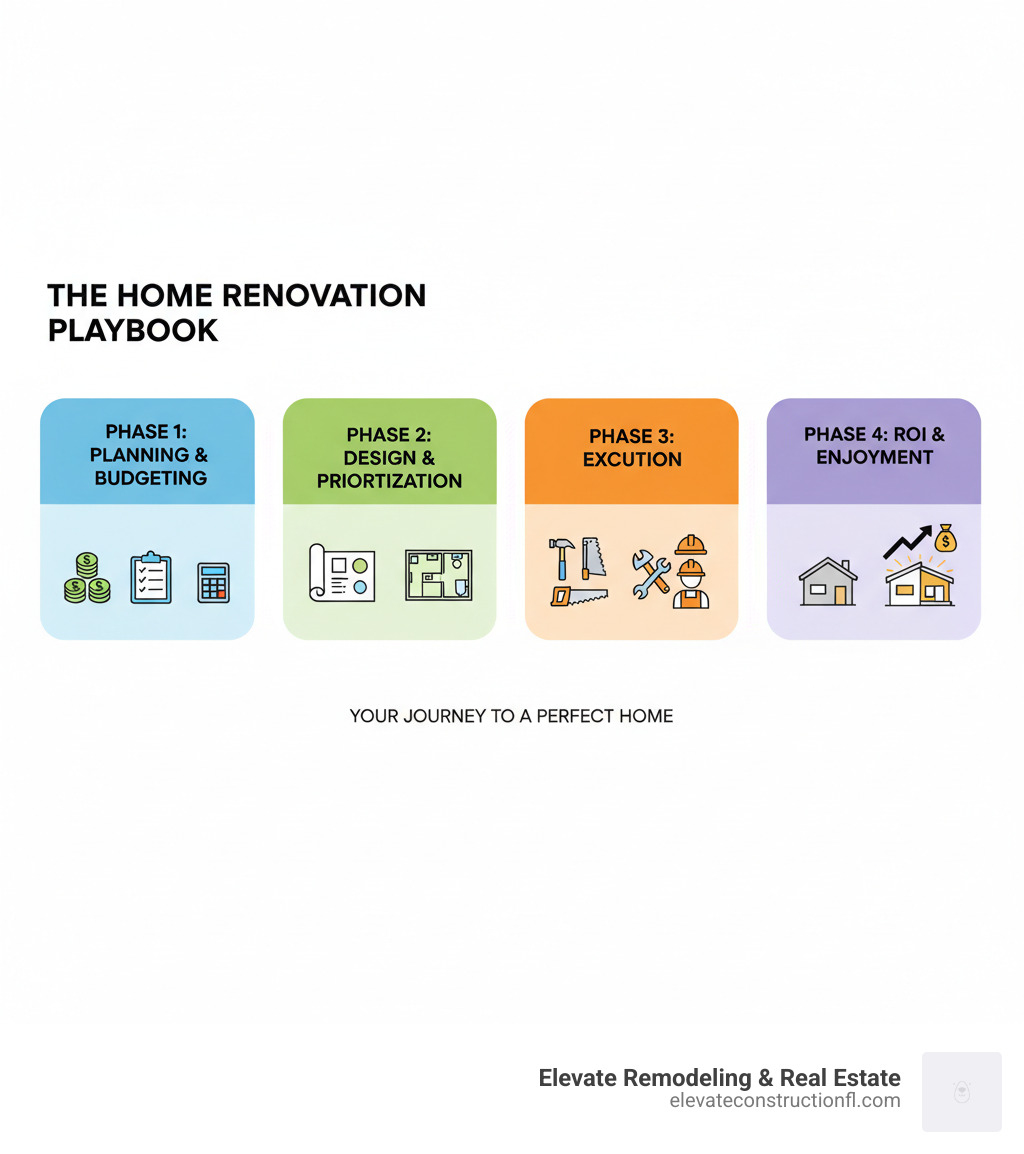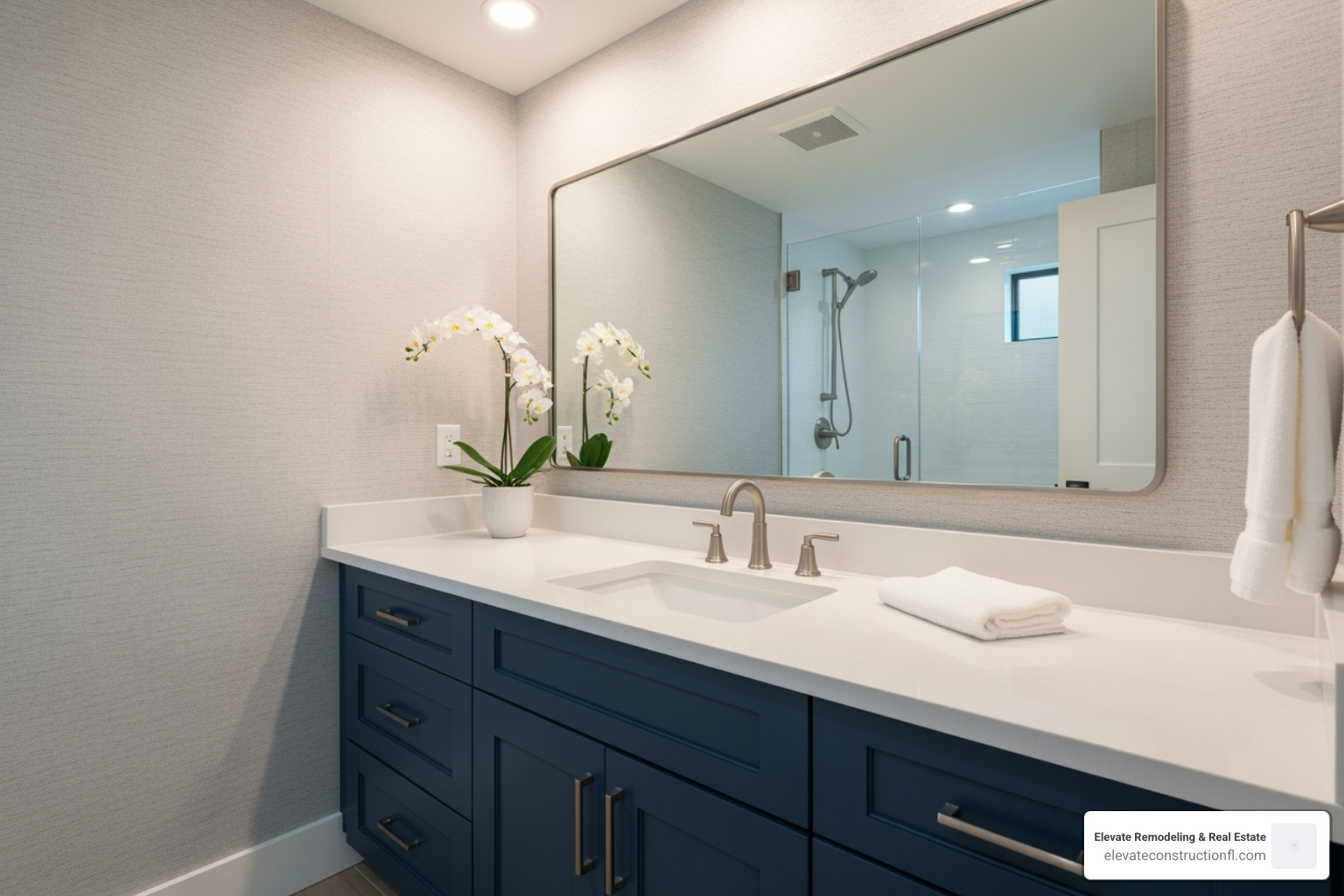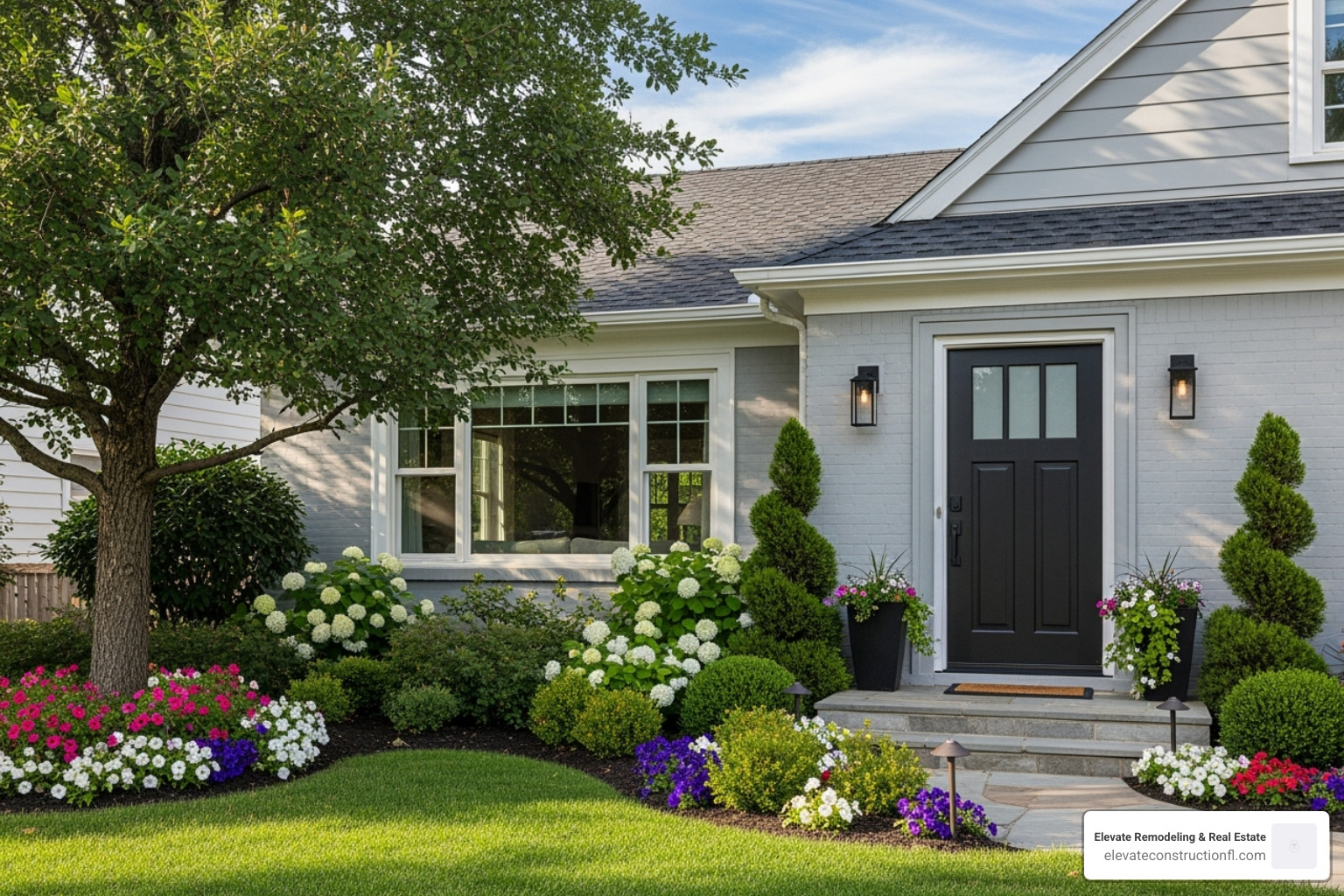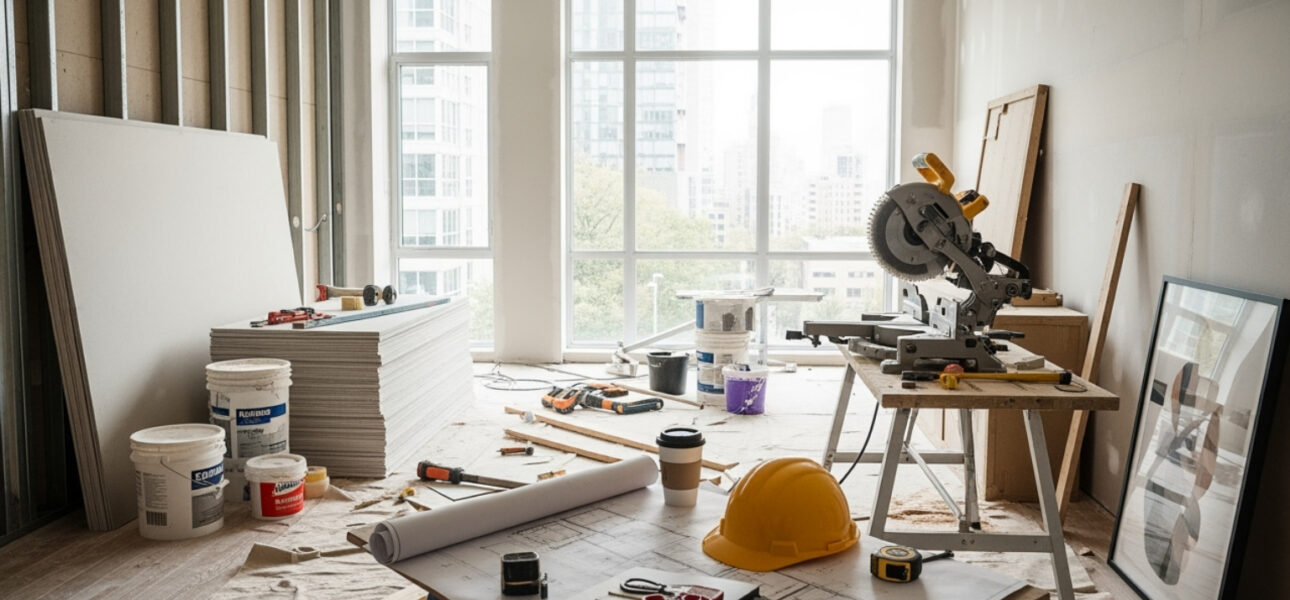Why Home Reno Projects Transform More Than Just Your Space
Home reno projects are a powerful way to increase property value, improve daily living, and create the space you’ve always dreamed of. Whether you’re planning a simple refresh or a complete overhaul, understanding the renovation process is crucial for success.
Essential Home Renovation Steps:
- Planning & Budgeting – Define your goals and set realistic financial expectations.
- Design & Prioritization – Focus on high-impact areas that match your lifestyle needs.
- Execution – Balance DIY projects with professional work for safety and quality.
- ROI Maximization – Choose renovations that add long-term value to your property.
The renovation boom continues to grow, with more than half of homeowners completing projects in recent years. Kitchen renovations typically offer a 75-100% return on investment, while simple improvements like painting can return 60% of costs. Even minor updates like new bathroom hardware or fresh flooring can dramatically transform your space without breaking the bank.
Smart planning makes the difference between a dream renovation and a costly nightmare. According to industry experts, many renovation problems stem directly from poor planning. With the right approach, you can avoid common pitfalls and achieve stunning results.

Phase 1: Strategic Planning and Budgeting
Every successful home reno begins with a clear plan. This first phase turns your renovation dreams into a practical roadmap. Think of strategic planning as your project’s GPS—without it, you risk costly detours.
How to Create a Renovation Plan
Start by defining your scope. Instead of a vague goal like “a new kitchen,” pinpoint what isn’t working. Is it a lack of counter space or a layout that feels isolating? Walk through your home and make a detailed inventory of what to change and what to keep.
Next, create a ‘Needs vs. Wants’ list. Needs are non-negotiables, like fixing a leaky roof or updating a faulty electrical panel. Wants are the upgrades that would make life more enjoyable, such as a farmhouse sink or a walk-in shower. Getting household input is also crucial, as others may have different priorities.
Using planning worksheets or a simple notebook can help transform this brainstorming into an actionable plan. Also, consider assessing future needs. Are you planning to grow your family, age in place, or start a home business? A good plan accounts for what’s coming, not just what’s happening now. Remember to prioritize the “bones” of your house first; structural and water issues should always take precedence over cosmetic changes.
Effectively Managing Your Renovation Budget
Setting a realistic budget is essential. Start by researching costs for your desired projects. For example, kitchen countertops can range from $500 for laminate to over $10,000 for premium stone.
Getting quotes from multiple contractors is a must. It provides a clear picture of market rates and helps you identify red flags, like a bid that’s unusually low. A non-negotiable rule is to create a contingency fund of 10-15% for unexpected issues like hidden water damage or outdated wiring.
According to a Bankrate survey on project postponement, economic uncertainty can cause delays, but smart planning helps you move forward with confidence. Track expenses diligently to stay on budget.
As for financing options, you have several choices:
- Savings: The most straightforward approach with no interest payments.
- Home Equity Loans & Lines of Credit: These use your home’s value as collateral, often providing lower interest rates than personal loans. A loan gives you a lump sum, while a line of credit is a revolving credit source.
For homeowners in Tampa Bay, Lift Remodeling & Real Estate offers comprehensive funding solutions to make your renovation dreams achievable. The key to budget success is to be realistic, plan for surprises, and remember that a well-executed home reno is an investment in your home’s long-term value.
Phase 2: Designing for Impact and Prioritizing Projects
With a plan and budget, you can move to the design phase. This is where your home reno vision takes shape. Start by gathering inspiration from design magazines, online galleries, and showrooms. Creating a digital folder or physical file of ideas will be invaluable when communicating your vision.
Working with experienced designers can be a game-changer. They translate abstract ideas into concrete plans, creating sketches and blueprints that ensure your design is both beautiful and buildable. Our team provides comprehensive architecture & design services to guide you through this creative process. A detailed wish list that distinguishes between ‘must-haves’ and ‘nice-to-haves’ is essential for making smart decisions if budget adjustments are needed.
Budget-Friendly Home Reno Ideas for Every Room
A major renovation isn’t always necessary to make a big impact. Strategic, affordable projects can dramatically transform your home.

- Kitchen Upgrades: If cabinets are in good shape, consider painting them and adding new hardware. Upgrading countertops with remnant stone pieces or installing a new backsplash (even peel-and-stick options) can modernize the space without a full overhaul.
- Bathroom Updates: Simple hardware swaps—faucets, showerheads, and towel bars—can have a huge effect. Painting the vanity and framing a builder-grade mirror are inexpensive ways to create a custom look.
- Living Room Refresh: A fresh coat of paint offers a high return on investment and completely changes a room’s feel. Updating old light fixtures and installing dimmer switches can also improve ambiance and functionality.
Prioritizing Projects for Maximum Impact
Not all projects are equal. Prioritize based on need, with foundational issues taking absolute precedence.
Structural repairs must come first. Before any cosmetic work, address critical issues like a leaky roof, foundation problems, or water damage. Ignoring these problems leads to more expensive repairs and can decrease your home’s value. Repairs that fix underlying issues often deliver an excellent ROI of 70-80%.
Once your home’s “bones” are sound, focus on cosmetic upgrades in high-traffic areas like kitchens and bathrooms, which consistently yield the best ROI. For large projects, consider phasing your renovations into smaller, manageable stages to align with your budget and minimize disruption. Being strategic about where you invest your time and money is key to a successful home reno.
Phase 3: Executing Your Home Reno: DIY vs. Hiring Professionals
With planning complete, it’s time to execute your home reno. This phase is about turning plans into reality, and the biggest decision is what to do yourself versus hiring a professional. Effective project management is crucial, requiring clear timelines and open communication. Our construction management services can help keep your project on track.

The Great Debate: DIY vs. Hiring a Pro
While DIY projects can be satisfying and save money, it’s important to be realistic about your skill level, available time, and access to the right tools. Some tasks are better suited for DIY than others.
- Good for DIY: Painting is a great starter project with low risk and high impact. Minor landscaping and hardware installation are also good candidates.
- Use Caution: Basic flooring or simple plumbing tasks like replacing a faucet can be done by a handy homeowner, but mistakes can be costly. One loose connection can cause a flood.
- Leave to Pros: Electrical work, cabinet installation, and anything structural should be handled by professionals. The risks of fire, injury, or damage are too high.
| Task | DIY: Cost | DIY: Time | DIY: Skill Level | DIY: Risks | Pro: Cost | Pro: Time | Pro: Skill Level | Pro: Risks |
|---|---|---|---|---|---|---|---|---|
| Painting | Low | Moderate | Low-Moderate | Uneven coats, drips, poor prep | Moderate | Fast | High | Overpriced, poor communication |
| Flooring | Moderate | Moderate-High | Moderate | Uneven installation, damage to subfloor | High | Fast | High | Subpar installation, material waste |
| Basic Plumbing | Low | Moderate | Low-Moderate | Leaks, water damage, code violations | Moderate | Fast | High | Improper installation, costly repairs |
| Electrical Work | Low | High | High | Fire hazard, shock, code violations, injury | High | Fast | High | Fire hazard, faulty wiring |
| Cabinet Install. | Moderate | High | Moderate-High | Misalignment, damage to cabinets/walls | High | Moderate | High | Misalignment, poor finish |
When to Always Call a Professional
Some jobs are simply too dangerous or complex for DIY. Always hire a licensed professional for:
- Plumbing, Electrical, and Gas Work: Mistakes can lead to floods, fires, or even explosions.
- Structural Changes: Removing walls or altering your home’s frame requires an expert to ensure its integrity.
- Roofing: This work is physically dangerous and technically complex.
- Lead Paint or Asbestos Removal: These hazardous materials require certified professionals for safe handling and disposal, per EPA guidelines.
- Projects Requiring Permits: Professionals are experienced in navigating the permit process to ensure all work is up to code.
Common Home Reno Mistakes and How to Avoid Them
Avoid these common pitfalls to keep your project on track:
- Poor Planning: Rushing into a project leads to overlooked costs and details. Plan thoroughly.
- Unrealistic Budgets: Always include a 10-15% contingency fund for unexpected issues.
- Choosing the Cheapest Contractor: Vet contractors carefully. The lowest bid can signal cut corners or hidden costs.
- Ignoring Structural Issues: Fix foundational problems before focusing on cosmetic upgrades.
- Changing Your Mind Mid-Project: “Scope creep” can destroy budgets and timelines. Finalize decisions before work begins.
- Skipping Permits: This can cause major legal and financial headaches later, especially when selling.
Phase 4: Maximizing Your Return on Investment (ROI)
A smart home reno balances personal enjoyment with your home’s financial future. Understanding which improvements deliver the best ROI helps you make choices you won’t regret, whether you plan to sell soon or stay for decades. Market conditions play a role, and having real estate expertise is invaluable. Our real estate services provide Tampa Bay homeowners with insider knowledge on current market trends.
Renovations with the Best ROI
Certain projects consistently deliver impressive returns while improving your daily life.

- Kitchen Renovations: The champion of ROI, typically returning 75-100% of the investment. Even minor updates like new countertops or appliances make a huge difference.
- Bathroom Renovations: These projects earn a solid 62% ROI on average. Focus on high-impact elements like a frameless glass shower or an updated vanity.
- Flooring Improvements: Often returning 100-150% of your investment. Hardwood floors are highly desirable to buyers.
- Painting: A simple coat of paint delivers about 60% ROI and makes spaces feel larger and more modern.
- Window Replacement: New windows offer a 75-80% ROI through improved aesthetics and energy efficiency.
- New Front Door: This small change creates a powerful first impression and adds significant curb appeal.
The Importance of Curb Appeal and Energy Efficiency
First impressions are critical. Curb appeal signals to buyers that a home is well-maintained. Focus on exterior maintenance like fresh paint or clean siding, simple landscaping, and effective outdoor lighting to create an inviting look.
Today’s buyers also prioritize energy efficiency for lower monthly bills. Renovations that improve efficiency can net a 70-80% ROI. Key projects include:
- Energy-efficient windows
- Insulation upgrades in the attic and walls
- A modern, high-efficiency HVAC system
These improvements create a win-win: you enjoy lower utility bills, and future buyers see the long-term value. It’s a forward-thinking approach that makes every home reno dollar work harder.
Frequently Asked Questions about Home Renovations
Here are answers to the most common home reno questions we hear from homeowners in the Tampa Bay area.
What is the most profitable home renovation?
For maximizing your investment, focus on kitchen and bathroom remodels. A minor kitchen remodel can recoup over 75% of its cost. Surprisingly, new flooring can sometimes return over 100% of your investment, as buyers love move-in-ready homes with updated floors. Don’t overlook curb appeal projects like a new front door or fresh exterior paint; they offer a high return for a relatively low cost.
How much should I budget for a home renovation?
A good rule of thumb is to budget 1-4% of your home’s value for annual maintenance. For major renovations, costs vary widely. A minor kitchen remodel might cost $15,000-$25,000, while a major one can exceed $70,000. The golden rule is to always add a 15-20% contingency fund to your final budget for unexpected issues that are common in any renovation.
Can I do a home renovation myself?
Yes, DIY is great for many cosmetic projects. Tasks like painting, installing new hardware, or minor landscaping are perfect for homeowners looking to save money and don’t require specialized skills. However, any work involving electrical, plumbing, gas, or structural changes must be left to licensed professionals. This ensures safety, compliance with building codes, and protects your home’s value. A “money-saving” DIY mistake can end up costing more to fix than hiring a pro from the start.
Conclusion: Bringing Your Vision to Life
Your home reno journey is the start of enjoying a space that truly reflects who you are. By following the four key phases—planning, design, execution, and ROI maximization—you have a roadmap for success.
A well-executed renovation is about more than just new materials; it’s about creating a home that improves how you live. It transforms frustrating layouts and outdated rooms into functional, beautiful spaces that bring you joy every day.
For homeowners in the Tampa Bay area looking for an all-in-one partner, the expert teams at Lift Remodeling & Real Estate provide comprehensive remodeling, real estate, and funding solutions. We understand that every home tells a story, and we’re here to help you write the next chapter.
Whether you’re dreaming of a minor refresh or planning a complete change, you don’t have to steer this journey alone. Our team is dedicated to turning renovation dreams into reality, on time and on budget.
Ready to start your home reno adventure? Contact us today to begin bringing your vision to life.

